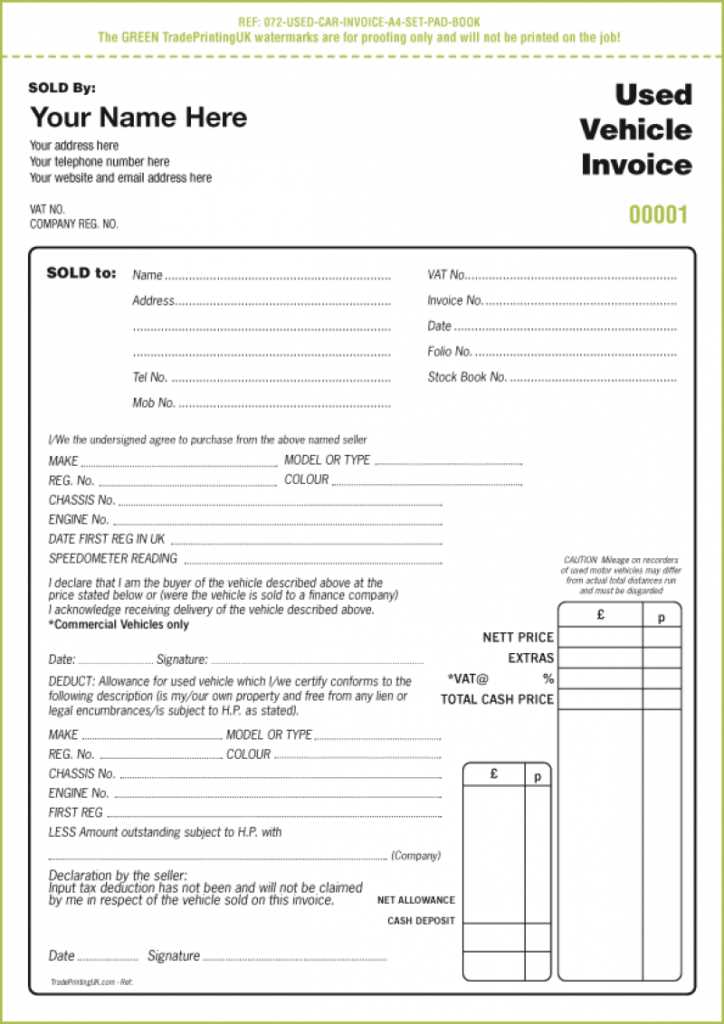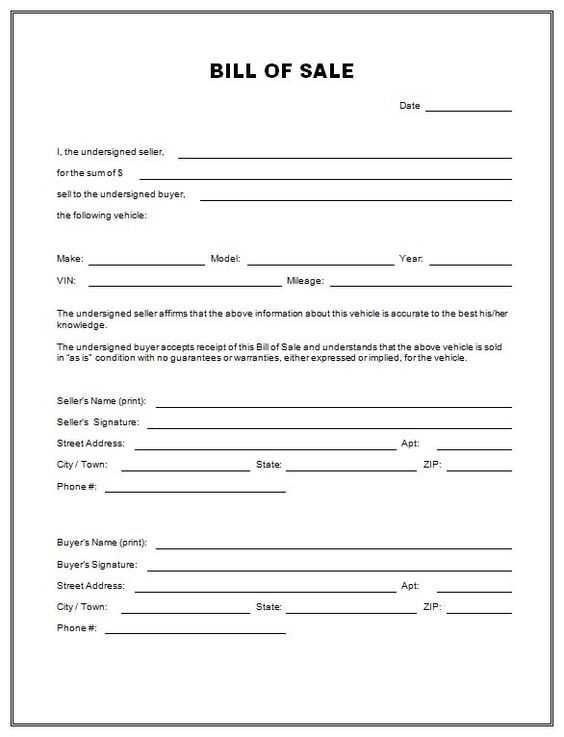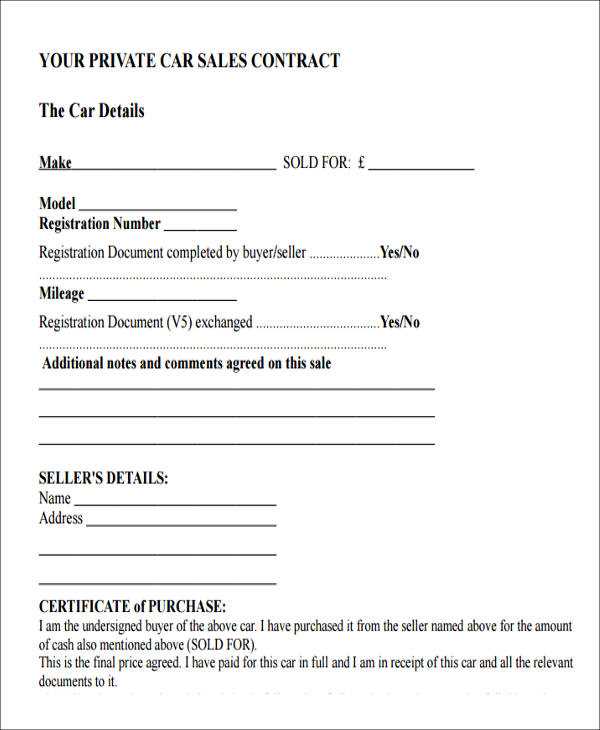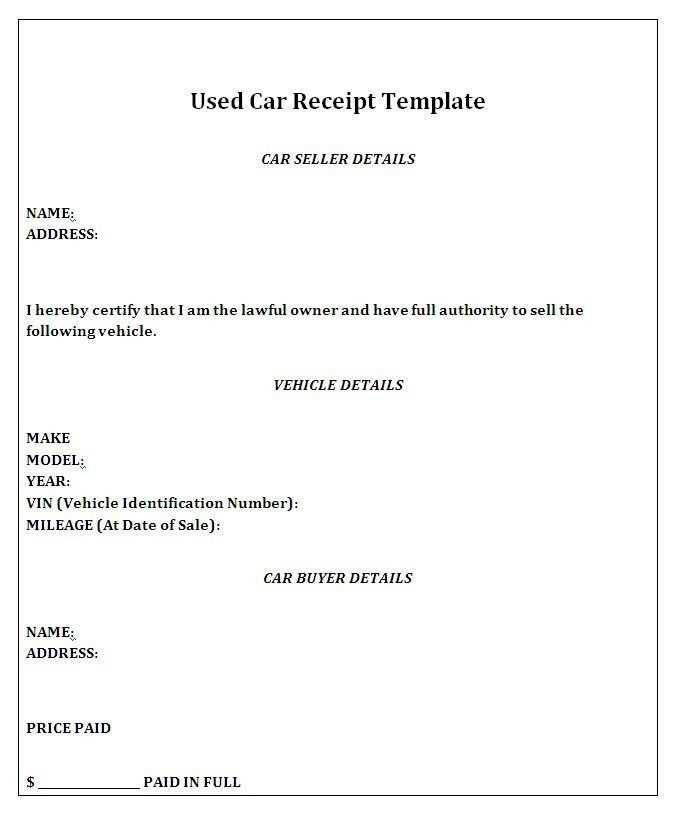
Always document your vehicle sale with a properly structured receipt. A well-drafted receipt protects both the buyer and the seller by confirming the transaction details and preventing future disputes.
Include essential information such as the vehicle’s make, model, year, VIN, sale price, and payment method. Clearly state whether the vehicle is sold “as is” or with specific warranties. Both parties should provide their full names, addresses, and contact details.
To ensure legal validity, include the date of sale and signatures from both the buyer and the seller. If required by local laws, have a witness or notary public sign the document. Always provide a copy to both parties for reference.
A well-prepared receipt simplifies title transfer and registration. Use a structured template to avoid missing critical details, ensuring a smooth and transparent transaction.
Here’s the corrected version with repetitions removed while maintaining the meaning:
Ensure your vehicle sale receipt is clear and concise, avoiding redundant details. Start with the buyer and seller information at the top of the document.
| Seller | Buyer |
|---|---|
| Name: [Seller’s Name] | Name: [Buyer’s Name] |
| Address: [Seller’s Address] | Address: [Buyer’s Address] |
| Phone: [Seller’s Phone] | Phone: [Buyer’s Phone] |
Next, include details about the vehicle. Provide the make, model, year, Vehicle Identification Number (VIN), and odometer reading. Double-check the VIN to ensure accuracy.
| Vehicle Information |
|---|
| Make: [Vehicle Make] |
| Model: [Vehicle Model] |
| Year: [Vehicle Year] |
| VIN: [Vehicle VIN] |
| Odometer: [Odometer Reading] |
Include the sale price and payment method. If applicable, list any warranties or guarantees attached to the sale.
| Sale Details |
|---|
| Sale Price: $[Amount] |
| Payment Method: [Cash, Check, or Financing] |
| Warranty: [Warranty Details, if applicable] |
Conclude by adding both parties’ signatures and the date of the transaction to validate the sale.
- Vehicle Sale Receipt Template
Creating a clear and accurate vehicle sale receipt protects both the buyer and the seller. The template should include key details like vehicle information, payment terms, and signatures. Here’s what to include:
Key Elements
The template must capture the following data:
- Vehicle Information: List the make, model, year, VIN (Vehicle Identification Number), and mileage at the time of sale.
- Buyer and Seller Details: Full names, addresses, and contact information of both parties.
- Sale Price: Clearly state the amount paid for the vehicle, along with any applicable taxes or fees.
- Payment Method: Specify whether the payment was made in cash, check, or via another method.
- Date of Transaction: The exact date the sale occurred.
- Signatures: Include a space for both parties to sign, confirming the sale and agreement to the terms.
Additional Considerations
Make sure to note whether the vehicle is sold “as is” or with a warranty. This protects both parties from future disputes regarding the vehicle’s condition. If any conditions were agreed upon, include them in writing on the receipt to avoid misunderstandings.
Include the full names of the buyer and seller to avoid confusion later. Also, note their contact information, such as addresses or phone numbers. This ensures both parties are clearly identified.
List the vehicle’s make, model, year, VIN (Vehicle Identification Number), and current mileage. These details confirm the specific vehicle being sold and protect against disputes.
Clearly state the sale price and payment method. If any deposit or down payment was made, include this information as well. Specify whether the payment was made in full or if there are outstanding amounts.
Describe the condition of the vehicle at the time of sale, including any known issues or defects. This prevents misunderstandings about the vehicle’s condition after the transaction.
Include a warranty or “as-is” clause, specifying whether the vehicle comes with a guarantee or if it’s being sold without any warranties. This will help avoid post-sale conflicts.
Ensure that both parties sign the receipt and include the date of sale. This solidifies the agreement and provides a point of reference should any issues arise later.
Ensure that the vehicle sale receipt complies with local laws and regulations. Include all required details such as the full names and addresses of both parties, the vehicle’s make, model, year, and VIN (Vehicle Identification Number). Clearly specify the date of sale and the sale price. Both buyer and seller should sign the receipt, acknowledging the transaction and its terms.
Check for any specific state or regional requirements, such as emissions or safety inspections, which may need to be documented. Make sure that the vehicle’s title transfer process is outlined and that it includes any necessary documents to complete the sale legally.
If the vehicle is sold “as is,” this should be explicitly stated to prevent future claims from the buyer regarding the condition of the car. Similarly, if any warranties or guarantees are offered, they must be clearly stated, including any limitations or conditions attached to them.
It’s also important to consider taxes and fees that might be applicable based on the sale price. Some jurisdictions may require that both parties pay or report sales tax, and the receipt should reflect this to avoid potential legal issues later on.
Finally, keep a copy of the signed receipt for record-keeping purposes, as it serves as proof of the transaction and may be needed for future reference in case of disputes or legal inquiries. Make sure all parties retain a copy for their records as well.
Clearly outline the total price, including taxes, fees, and any additional charges. Break down the cost into individual components (vehicle price, registration fees, etc.), making it transparent for both parties. This will avoid confusion and ensure that the buyer understands exactly what they are paying for.
Specify the payment method(s) and conditions. Whether the buyer is paying through financing, a down payment, or full cash, include this detail. If there is an installment plan, state the interest rates, due dates, and penalties for late payments.
If the sale includes any discounts or rebates, make sure they are highlighted. Include a line-item breakdown to show how these have been applied to the final price.
Be clear about any deposits made or non-refundable amounts. Ensure both parties understand what is refundable and under what circumstances. This helps set the right expectations from the start.
Buyer and Seller Identification
Ensure the buyer and seller are clearly identified in the receipt. Include full names, addresses, and contact information for both parties. This will avoid any confusion and make it easier to resolve any issues that may arise in the future.
Seller Details
- Full Name: Include the full legal name of the seller.
- Address: Specify the seller’s residential or business address.
- Contact Information: Provide a phone number or email address for communication.
Buyer Details
- Full Name: List the buyer’s complete name as it appears on their ID.
- Address: Write the buyer’s current address, ensuring accuracy.
- Contact Information: Provide a way to reach the buyer, either by phone or email.
These details should be accurate and complete, as they help establish the legal identity of the parties involved in the transaction. This information is also crucial for any future correspondence or disputes related to the vehicle sale.
Be precise when recording vehicle details on the sale receipt. Incorrect VIN numbers, misspelled names, or wrong vehicle information can cause confusion later. Double-check all the specifics before finalizing the document.
1. Inaccurate Buyer or Seller Information
Ensure both buyer and seller details are clearly listed. Verify the full names, addresses, and contact information for accuracy. This helps prevent disputes or confusion if any issues arise post-sale.
2. Missing or Incorrect Payment Information

Include accurate payment details on the receipt. Specify the payment method (cash, check, transfer) and the total amount. If a deposit has been made, note it and list any outstanding balance clearly.
3. Not Specifying the Date of Sale
Always add the exact date of sale on the receipt. Omitting this detail can create problems when it comes to taxes, warranties, or disputes regarding the timing of the transaction.
4. Leaving Out Important Vehicle Condition Information
Describe the vehicle’s condition in detail, including any known issues or repairs. Without this information, both parties may face challenges in proving the car’s condition at the time of sale.
5. Overlooking Signatures

Ensure both parties sign the receipt. This step confirms mutual agreement on the transaction. Without signatures, the document is not legally binding.
6. Forgetting to Provide Copies

Both the buyer and seller should receive a copy of the receipt. This serves as a record for both parties and can be used for future reference if needed.
Choosing between printable and digital formats for a vehicle sale receipt depends on convenience, legal needs, and storage preferences. Both formats serve their purpose well, but understanding their differences will help you make the right decision.
Printable Format
For those who prefer a physical copy, a printable format is the go-to option. It allows for immediate hard-copy documentation, which can be important for record-keeping, tax purposes, or legal evidence in case of disputes. Simply print the document on standard paper or customize it with a specific design before printing.
Digital Format
A digital format is ideal for fast access and storage. These receipts can be easily emailed, stored on cloud services, or saved to devices. Digital copies reduce paper waste and make retrieving receipts quicker. Ensure the digital format is backed up for safekeeping.
| Feature | Printable Format | Digital Format |
|---|---|---|
| Storage | Physical filing | Cloud or device storage |
| Accessibility | Access limited to physical copy | Access anywhere with an internet connection |
| Legal Use | Accepted as proof with physical signature | May require digital signature or confirmation |
| Environmental Impact | Uses paper | Eco-friendly, reduces paper waste |
| Convenience | Immediate physical record | Easy to store and share digitally |
In summary, both formats have unique advantages. Print receipts for tangible documentation, or opt for digital versions for easy access and eco-friendly storage.
Vehicle Sale Receipt Template
To create a clear and professional vehicle sale receipt, begin with the seller’s and buyer’s full names and contact information. Include the date of the transaction and the vehicle’s identification number (VIN). Specify the make, model, year, color, and mileage of the vehicle being sold.
Key Details to Include

The price agreed upon should be clearly stated along with the payment method (e.g., cash, check, bank transfer). Mention any deposits made before the full payment. Include a section noting whether the vehicle is sold “as is” or with any warranties or guarantees. If the vehicle was inspected by the buyer, add a statement confirming the inspection and acceptance of the condition of the vehicle.
Signature Section
Both parties should sign and date the receipt, with a space for witnesses if needed. It’s recommended to also include a statement of acknowledgment that both parties agree to the terms outlined in the document.


